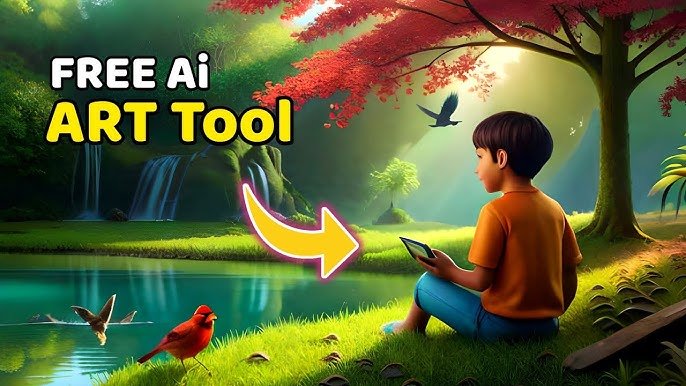Artificial Intelligence (AI) has witnessed an incredible evolution in recent years, and one of the most fascinating advancements is in the realm of text-to-image generation. This technology allows users to generate images from written descriptions, offering a profound way to bridge the gap between language and visual art. From creating hyper-realistic scenes to abstract designs, text-to-image AI has emerged as a powerful tool that is transforming various industries, from entertainment to marketing, education, and beyond.
How Text-to-Image AI Works
At its core, text-to-image AI uses a combination of natural language processing (NLP) and computer vision techniques to interpret written descriptions and convert them into corresponding images. The process involves training deep learning models on vast datasets of paired text and images, allowing the AI to understand how specific words and phrases correlate with visual elements.
These models are based on Generative Adversarial Networks (GANs) or more recently, diffusion models, which work by generating an image from random noise and refining it step-by-step to align with the text input. The AI learns to associate common objects, scenes, and even artistic styles with certain words, making it capable of creating a wide range of visuals.
The most notable platforms that use text-to-image AI include OpenAI’s DALL·E, Stable Diffusion, and MidJourney, which allow users to input detailed descriptions and receive highly specific images in return. Over time, these models have improved in accuracy, style flexibility, and the ability to handle complex prompts.
Impact on Creative Industries
Text-to-image AI has revolutionized the way creatives approach visual design. Artists, graphic designers, and illustrators can now use AI tools to quickly generate mock-ups, concepts, and visual inspiration that might have once taken hours or even days to produce.
Enhancing Art and Design
For artists, text-to-image AI offers a new medium for creativity. It can act as a co-creator, helping artists explore new ideas and push the boundaries of traditional techniques. Whether it’s creating surreal landscapes, combining unrelated objects, or experimenting with different art styles, these tools have empowered artists to bring their most ambitious ideas to life without needing advanced technical skills.
Designers can also leverage AI for rapid prototyping, testing different design elements, or creating realistic simulations of how a product might look in various environments. This flexibility has transformed industries like fashion, advertising, and architecture, where visual content plays a key role in marketing strategies.
Gaming and Animation
In the gaming and animation sectors, text-to-image AI has enabled game developers and animators to quickly generate backgrounds, characters, and assets, streamlining the development process. AI-generated art can be used as placeholders during early design stages, allowing creators to visualize concepts without requiring detailed manual creation.
The potential for AI to assist in creating entire gaming worlds or virtual environments based solely on text inputs could significantly reduce the time and costs involved in game production.
Marketing and Advertising
For marketers and advertisers, text-to-image AI has introduced a new way to create personalized and highly engaging content. AI-generated imagery can be tailored to specific campaigns or consumer preferences, allowing for quick adaptation to market trends. Whether it’s producing a new ad visual, social media graphic, or website design, text-to-image AI offers an efficient and scalable solution to meet high demands for fresh content.
Ethical and Legal Considerations
As with any new technology, the rise of text-to-image AI raises important ethical and legal questions. One concern is the potential for AI to generate misleading or harmful content, such as deepfake images, misinformation, or inappropriate visuals. There is also the issue of intellectual property—AI-generated images may inadvertently mimic the work of human artists, leading to debates over copyright and authorship.
To address these challenges, it is crucial to implement safeguards that regulate how text-to-image AI is used. Developers are working on creating better detection methods for AI-generated content and establishing ethical guidelines for its application. As the technology evolves, discussions around the responsible use of AI in art and media will become increasingly important.
The Future of Text-to-Image AI
The potential for text-to-image AI is limitless, with future advancements expected to make AI-generated imagery even more accurate and diverse. As models continue to improve, users will be able to generate even more complex and realistic images with just a few lines of text.
Integration with Other Technologies
One exciting future development is the integration of text-to-image AI with other cutting-edge technologies like augmented reality (AR) and virtual reality (VR). Imagine being able to describe a world in text and then explore it in immersive 3D, or creating personalized virtual environments for gaming, training, or education based on your written instructions. This could open up entirely new possibilities for interactive experiences.
Democratizing Art and Design
Text-to-image AI also democratizes access to visual creativity. People who may not have the technical skills to create high-quality images can now generate visuals that are both professional and personalized. This could empower a wide range of people to engage in creative pursuits, whether they are designing websites, writing stories, or simply expressing themselves through art.
Conclusion
Text-to-image AI has opened up new creative frontiers, allowing artists, designers, marketers, and everyday users to generate images from written descriptions. This breakthrough has the potential to revolutionize industries across the board, making visual content creation faster, more accessible, and more diverse. However, as the technology continues to evolve, it will be essential to address the ethical and legal implications surrounding its use. The future of text-to-image AI promises even more exciting developments, with opportunities for integration into new technologies and the democratization of visual creativity.




